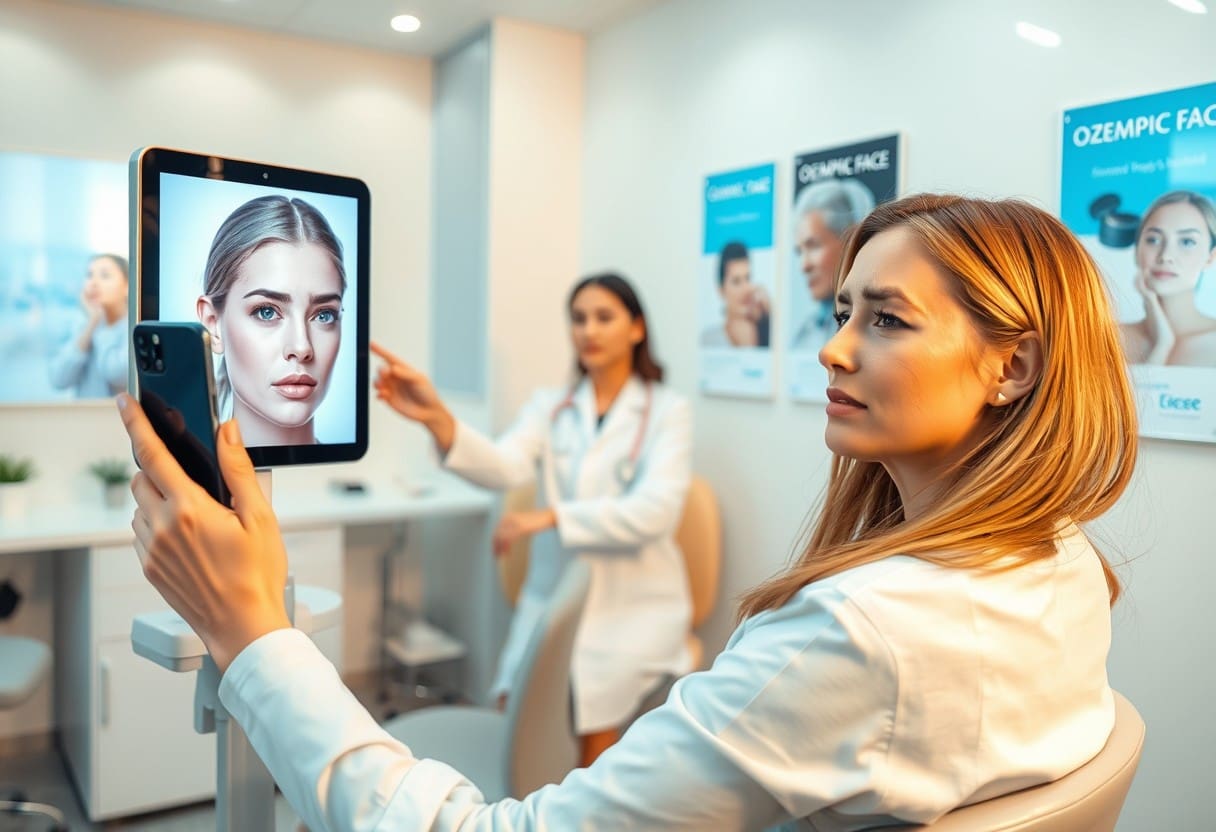Have you heard of “Ozempic face”? It’s a term used to describe the changes in facial appearance that can occur after significant weight loss, particularly when taking medications like Ozempic or similar drugs. As you shed pounds, you may notice a hollowed-out look, increased wrinkles, sunken eyes, and sagging skin around your jaw and neck. But can these effects be prevented or minimized? In this article, we’ll explore the causes of Ozempic face, how to avoid it, and what treatment options are available. Whether you’re considering weight loss medication or have already started your journey, it’s vital to understand the potential impact on your skin and what you can do to maintain a healthy, radiant appearance. Visit NJTrimClinic.com to learn more.

Key Takeaways:
- Ozempic Face is a term used to describe the appearance of the face after weight loss, specifically weight loss that occurs after taking Ozempic or similar medications.
- The facial effects of weight loss can happen with any medication similar to Ozempic, or just from rapid weight loss in general, and are not limited to Ozempic.
- GLP-1 agonist medications, such as Ozempic, Saxenda, and Wegovy, can promote weight loss, but may also cause facial side effects like a hollowed-out look, wrinkles, sunken eyes, and sagging skin.
- The likelihood of experiencing Ozempic face increases with rapid weight loss, which can lead to saggy skin, especially if you lose a lot of weight in a short amount of time.
- To minimize the effects of Ozempic face, it’s necessary to stay hydrated, eat enough calories, prioritize protein, and exercise regularly.
- Treatment options for Ozempic face include facial fillers, platelet-rich plasma shots, microneedling, fat transfer, and plastic surgery, each with its own risks and benefits.
- Healthy practices like not smoking, eating well, prioritizing skin care, getting plenty of sleep, and considering collagen supplements can help improve the appearance of your skin and boost its volume naturally. Learn more about weight loss and Ozempic face at NJTrimClinic.com.
What Is Ozempic Face?
Before we explore the world of Ozempic face, let’s take a step back and understand what it’s all about.
Definition and Description
What exactly is Ozempic face? Simply put, it’s a term used to describe the appearance of the face after significant weight loss, particularly when taking Ozempic or similar medications. This phenomenon is characterized by a hollowness in the cheeks, extra skin, and a more aged appearance.
Medical Perspective
One of the primary concerns with Ozempic face is that it’s not a medically recognized term. In fact, using this term can perpetuate negative attitudes towards weight and obesity, adding to the stigma surrounding these issues.
This medical perspective highlights the importance of understanding that facial effects can occur with any weight loss medication, not just Ozempic. The key takeaway is that rapid weight loss, regardless of the method, can lead to facial changes.
At NJTrimClinic.com, our team of experts is dedicated to providing you with the most accurate and up-to-date information on weight loss and its effects on your body. Stay tuned for more insights on Ozempic face and how to navigate its challenges.
What Causes Ozempic Face?
Some people who take Ozempic or similar medications for weight loss may experience facial changes, commonly referred to as “Ozempic face.” But what exactly causes these changes?
Rapid weight loss is a significant contributor to the development of Ozempic face. When you lose weight quickly, your skin may not have time to adapt, leading to sagging and a hollowed-out appearance.
Rapid Weight Loss
Loss of fat in the face can result in a gaunt or hollow appearance, especially if weight loss occurs rapidly. This is because the skin doesn’t have time to adjust to the new contours of the face, leading to excess skin and a less youthful appearance.
Aging and Skin Elasticity
The natural aging process can also contribute to Ozempic face. As we age, our skin loses its elasticity and ability to snap back into place, making it more prone to sagging and wrinkles. When combined with rapid weight loss, this can exacerbate the appearance of Ozempic face.
Another factor to consider is that aging skin is less able to adapt to changes in facial fat distribution. As we age, our skin’s natural regenerative processes slow down, making it more challenging for the skin to recover from weight loss-related changes.
GLP-1 Agonist Medications
For individuals taking GLP-1 agonist medications like Ozempic, the medication itself can contribute to Ozempic face. These medications work by reducing hunger and increasing feelings of fullness, leading to weight loss. However, they can also cause changes in facial fat distribution, leading to a hollowed-out appearance.
This is because GLP-1 agonist medications can affect the way the body distributes fat, leading to a loss of fat in the face and other areas. While this can be beneficial for overall weight loss, it can also result in unwanted facial changes.
Be mindful of, it’s imperative to discuss any concerns you have about Ozempic face with your healthcare provider. They can help you determine the best course of action for your individual situation. If you’re interested in learning more about weight loss and Ozempic face, visit NJTrimClinic.com for more information.
How to Avoid Ozempic Face
Unlike other weight loss medications, Ozempic face can be prevented or minimized with healthy habits and a slower weight loss rate. Here are some tips to help you avoid Ozempic face:
Healthy Habits
Avoid drastic changes to your diet and exercise routine, as this can lead to rapid weight loss and increased risk of Ozempic face. Instead, focus on making sustainable lifestyle changes that promote healthy weight loss.
Slower Weight Loss Rate
Healthy weight loss is all about patience and persistence. Aim for a weight loss rate of 1-2 pounds per week, as recommended by experts. This slower rate of weight loss can help reduce the risk of Ozempic face.
Slower weight loss also gives your skin time to adjust to the changes in your body. When you lose weight too quickly, your skin may not have time to shrink and adapt, leading to sagging skin and a hollow appearance.
Exercise and Nutrition
Habits such as regular exercise and a balanced diet can help promote healthy weight loss and reduce the risk of Ozempic face. Focus on building muscle mass through resistance training and eating a diet rich in protein, vitamins, and minerals.
Face the facts: a healthy lifestyle is key to avoiding Ozempic face. By focusing on sustainable weight loss and healthy habits, you can reduce the risk of facial side effects and achieve a more youthful, radiant appearance. Learn more about our weight loss programs at NJTrimClinic.com and take the first step towards a healthier, happier you.

Ozempic Face Treatment
Once again, it’s necessary to remember that “Ozempic face” is not a medical term, and the facial effects of weight loss can happen with any medication similar to Ozempic or just from rapid weight loss in general. If you’re concerned about the appearance of your face after weight loss, there are several treatment options available. Keep in mind that each treatment comes with its own risks, and it’s crucial to discuss them with your doctor.
At New Jersey Trim Clinic, our team of experts can help you find the right treatment for your unique needs.
Facial Fillers
Face the facts: facial fillers can help smooth out wrinkles and lines on your face by plumping them up. Typically, a dermatologist performs the procedure, injecting a filler made in a lab or fat from your own body into specific spots on your face.
Platelet-rich Plasma Shots
Shots of platelet-rich plasma can trigger cell reproduction and tissue regeneration, potentially reducing wrinkles and plumping skin. However, more research is needed to confirm its effectiveness.
To understand how platelet-rich plasma shots work, it’s necessary to know that platelets have growth factors that can stimulate cell reproduction and tissue regeneration or healing. By injecting platelet-rich plasma into targeted spots on your face, you may see improvements in skin texture and volume.
Microneedling
Microneedling involves creating small holes in the top layer of your skin using very thin needles, stimulating collagen and elastin production to help smooth out fine wrinkles and loose skin.
Treatment with microneedling can help improve skin texture and reduce the appearance of fine wrinkles. After the procedure, your skin may be red or swollen for up to 5 days, and there’s a risk of bruising, scarring, and skin infection.
Fat Transfer
For a more permanent solution, fat transfer involves liposuction on a part of your body with excess fat, which is then injected into areas of your face that need more volume.
With fat transfer, you can expect a recovery period of 3-7 days, and it may take around 6 months for the transferred fat cells to create a new blood supply before you see your final results. Risks include bleeding, fat embolism, fluid buildup under your skin, death of injected fat cells, scarring, and more.
Plastic Surgery
One option for restoring volume to your face is through plastic surgery, such as a facelift and/or neck lift, or cheek implants. While these procedures can be effective, they come with significant risks and require careful consideration.
Another important thing to keep in mind is that plastic surgery is a major decision, and it’s crucial to weigh the potential benefits against the risks and costs. It’s necessary to consult with a qualified surgeon to determine if plastic surgery is right for you.
Recall, it’s always a good idea to consult with a healthcare professional before making any decisions about treatment. They can help you determine the best course of action for your unique needs and concerns. Visit NJTrimClinic.com to learn more about our services and schedule a consultation today!

Does Ozempic Face Go Away?
For individuals who experience the unwanted effects of Ozempic face, the question remains: can these changes be reversed or prevented? While there is no straightforward answer, understanding the factors that contribute to Ozempic face can help you navigate the possibilities.
Weight Gain and Loss
Faces that have lost fat and volume due to Ozempic or similar medications may regain some of that lost volume with weight gain. However, this is not a guaranteed solution, as the skin’s elasticity and ability to snap back into place can be compromised with significant weight fluctuations. Additionally, weight gain may not necessarily distribute evenly, leading to uneven facial contours.
Natural Remedies
Naturally, you may wonder if there are ways to restore facial volume without resorting to medical treatments. Fortunately, certain healthy practices can improve the appearance of your skin and even help boost its volume.
Plus, incorporating habits like a balanced diet rich in antioxidants, regular exercise, and proper sleep can help maintain healthy skin and reduce the visible signs of aging. Additionally, staying hydrated, managing stress, and avoiding harsh skincare products can also contribute to a more radiant and plump complexion. While these methods may not completely reverse Ozempic face, they can certainly help mitigate its effects.
At NJTrimClinic.com, our team of experts is dedicated to providing personalized guidance and support for individuals seeking to manage their weight and improve their overall health. If you’re concerned about Ozempic face or would like to learn more about our services, please don’t hesitate to reach out.
Final Words
Hence, it’s imperative to understand that “Ozempic face” is not a medical term, but rather a colloquialism used to describe the facial effects of weight loss, particularly when taking medications like Ozempic or similar drugs. While it may be challenging to prevent these effects entirely, adopting a healthy lifestyle, including a balanced diet, regular exercise, and proper skin care, can help mitigate some of the issues. If you’re concerned about the facial side effects of weight loss, consult with a healthcare professional or visit New Jersey Trim Clinic | Somers Point NJ for personalized guidance. Recall, a healthy approach to weight loss is key, and you can find more information on this topic at NJTrimClinic.com.
FAQ
Q: What is Ozempic Face?
A: “Ozempic face” is a term used to describe the appearance of the face after weight loss, specifically when taking Ozempic or similar medications. It refers to a hollowness in the cheeks or extra skin that can show up when you lose fat in your face. However, “Ozempic face” is not a medical term and can increase the stigma around weight.
Q: What Causes Ozempic Face?
A: Ozempic face is caused by rapid weight loss, which can lead to saggy skin, especially in the face. This is because the skin is less able to adjust to changes as you age, and taking Ozempic or similar drugs may bring on the appearance of facial aging faster. Additionally, losing fat in the face can cause a hollowed-out look, increased wrinkles, sunken eyes, and sagging skin around the jaw and neck.
Q: How to Avoid Ozempic Face
A: While it may not be possible to completely prevent Ozempic face, there are ways to stay healthy and lessen its effects: drink plenty of water, choose a drug or dosage with a slower weight loss rate, eat enough calories, pay attention to protein, and exercise regularly. These habits can help maintain skin elasticity and tone the muscles under the skin.
Q: What Are the Treatment Options for Ozempic Face?
A: If you’re concerned about the appearance of your face after weight loss, there are several treatment options available: facial fillers, platelet-rich plasma shots, microneedling, fat transfer, and plastic surgery. Each treatment comes with its own risks and benefits, and it’s crucial to consult with a doctor to determine the best option for you.
Q: Does Ozempic Face Go Away?
A: The way your face looks will change as you gain and lose weight. Most people who experience Ozempic face may see some improvement over time, but it may not completely go away. Maintaining a healthy lifestyle, including a balanced diet and regular exercise, can help improve the appearance of your skin and reduce the signs of aging.
Q: What Are Some Natural Ways to Restore Volume to My Face?
A: Certain healthy practices can improve the appearance of your skin and even help boost your skin’s volume. These include not smoking, eating a well-balanced diet, prioritizing skin care, getting plenty of sleep, and trying collagen supplements. Visit NJTrimClinic.com to learn more about maintaining a healthy weight and improving your overall well-being.
Q: Where Can I Learn More About Ozempic Face and Weight Loss?
A: For more information about Ozempic face, weight loss, and treatment options, visit NJTrimClinic.com. Our team of experts is dedicated to providing personalized guidance and support to help you achieve your weight loss goals and improve your overall health.
